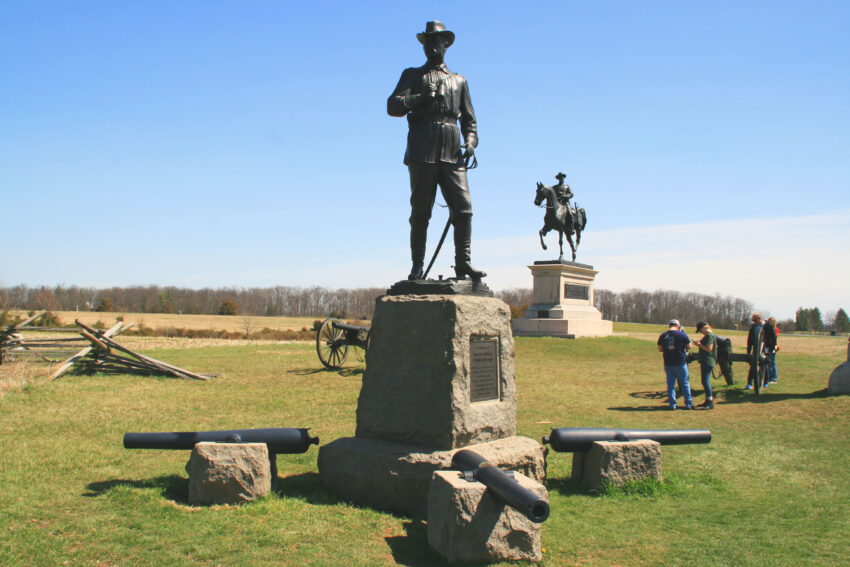
A Sojourn to Gettysburg National Military Park: An Epic Clash of Ideals
By Frank Hosek
Traveling southbound through southeastern Pennsylvania on Chambersburg Pike, we passed by dormant farm fields that had just recently shaken off winter’s blanket. Spring coolness prevailed but the sun shone brightly on an April afternoon.
Although we were headed towards Gettysburg, I was still caught unawares as we crested a ridge and came face-to-face with immense statues of two Union Generals framed by a pale blue sky.
We Entered Gettysburg National Military Park
A lifelong aficionado of the American Civil War, I only knew about The Battle of Gettysburg from a small library of books and magazines, but wanting to visit the site for years. Still, I was surprised at the emotions that welled up in me as I pulled the truck over, exiting with camera in hand, and without a look back to see whether or not my wife, Kathy, was following me, I trotted excitedly across the Pike.
In the shadows of the 15’ tall granite & bronze statue of cavalry commander Union Brigadier General John Buford, I stood where the first shots opened the battle.

A much smaller force of dismounted Union troopers slowed the advance of General Heth’s division of Confederate infantry as it resolutely rolled forward. All around me were gently rolling farmlands, nearby was McPherson’s barn, a stoic survivor of the conflict. On the horizon stood the town of Gettysburg. A small Pennsylvania farm community was thrust into a conflagration of unimaginable ferocity.
From the direction of the town, Major General John Reynolds’ Union infantry had arrived just in time to temporarily halt the flood of Confederates. Reynolds was instantly killed while leading his troops into the fray.
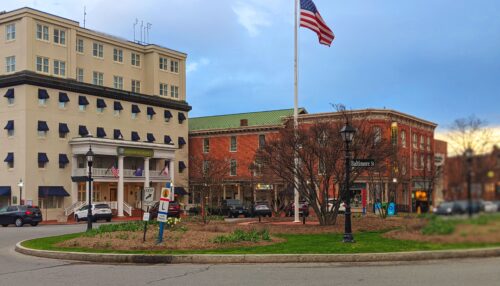
Thus began one of the most critical battles of the American Civil War. 160 years ago this year, the first three days of July, saw the largest battle ever fought in North America. General Lee’s Confederate Army clashed with General Meade’s Union Army.
More than 170,000 soldiers converged on the sleepy hamlet and fought for three days with a determination to destroy each other.
When it ended in the waning hours of an afternoon on July 3, more than 50,000 soldiers were dead, wounded, or missing.
Many more would die later from their wounds. The Confederate army was forced to retreat from northern soil. Although the war would last for nearly 2 more years, the South’s chances for dissolving the Union would never again reach the heights they had at Gettysburg.
Kathy reminded me of the time, so I reluctantly tore myself away so that we could head to the park’s Museum & Visitor’s Center.
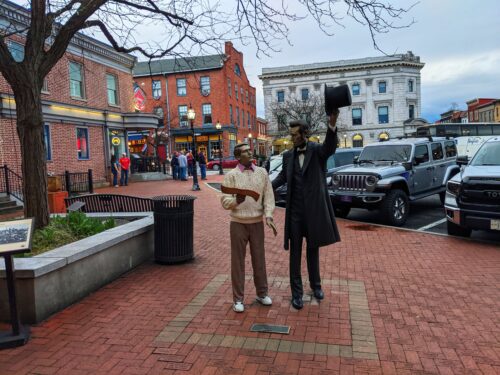
The museum’s 20,000 square feet features artifacts of the Battle of Gettysburg, exhibits that delve into the causes of the war, and explores the hardships of the men involved.
Imagine wearing heavy wool clothing and leather shoes on a hot, July day while hefting a ten-pound gun and some 80 lbs. of ammunition, food, water, and other necessities.
We sat through A New Birth of Freedom, an informative 22-minute introductory film narrated by actor Morgan Freeman.
Although I enjoyed it, I did not realize how enlightening it was until Kathy commented that it helped to clarify the war for her better than anything previously. Afterward, we were ushered into one of the most stunning aspects of the museum.
The $103 million museum and visitor center is home to the restored famed cyclorama, a 377-foot circular painting capturing the last day’s final assault, known as Pickett’s Charge. Created in 1884 by the French artist Paul Philippoteaux and a team of 20 artists it is 42 feet high and weighs 12.5 tons.
As we stood on a raised platform in the center of the massive spherical room, a narrator described the intense fighting as lights illuminated portions of the giant painting and sounds of battle emanated from a distance. It is difficult to describe how impactful the painting is. You feel as though you’ve been dropped just behind the angle’s stonewall at the apex of the assault, wondering who will prevail.
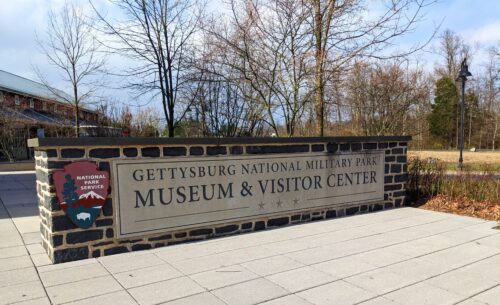
With a battlefield map in hand, we left the museum. The sun was low in the sky which was somewhat appropriate as I drove us to Culp’s Hill.
Occupied by Union troops, it was the critical right flank of the Union defensive line at Gettysburg and the so-called “barbed” portion of what is described as the “fish-hook” line of defenses.
It saw continuous fighting all 3 days but it was the fateful decision not to make a final night attack on the first day that may have sealed the South’s fate.
Monuments honored the various brigades and their positions on the field. There are approximately 1,328 monuments, markers and memorials throughout the park.
As I walked the trails, I imagined the determination needed as spent, tired men grappled over the rocky, heavily wooded hill that seemed nearly impenetrable.’
 Climbing the Observation Tower
Climbing the Observation Tower
Today the summit of the hill is topped with a 60-foot-tall observation tower. After climbing 7 flights of stairs, we were presented with a spectacular view of the battlefield. I found myself pointing out landmarks and reciting troop movements to my very patient wife.
Finally, with reluctance, we drove into the picturesque downtown of Gettysburg and checked into the Gettysburg Hotel located on Lincoln Square. Opened as Scott’s Tavern in 1797, this iconic guesthouse weathered the battle.
Rebuilt in 1991
Rebuilt with modern amenities in 1991, we found it to be delightful and very comfortable. In addition, it is steps away from the Wills House where President Abraham Lincoln spent the night and polished his Address.
Early the following morning, against a cold northerly wind that had covered the fields in frost, we made our way down Baltimore Pike to East Cemetery Hill.
A tour guide and a small group of like-minded enthusiasts were discussing the heavy fighting near the Evergreen Cemetery Gatehouse. Tearing myself away from the conversation we went on to The Soldiers’ National Cemetery.
Located on Cemetery Hill, It was here at a ceremony dedicating the hallowed ground, 4 months after the Battle of Gettysburg, that President Lincoln delivered those words that he thought, “The world will little note, nor long remember what we say here.”
Instead, it became one of the most famous speeches in American history, “The Gettysburg Address”. The memory of Lincoln permeates the area.
At the center of the cemetery stands the Soldiers’ National Monument with Union gravesites fanning out in a semicircular fashion from the base of the Monument. The cemetery contains the graves of over 3,500 from the battle, including the graves of 979 unknowns.
Big and Little Round Tops
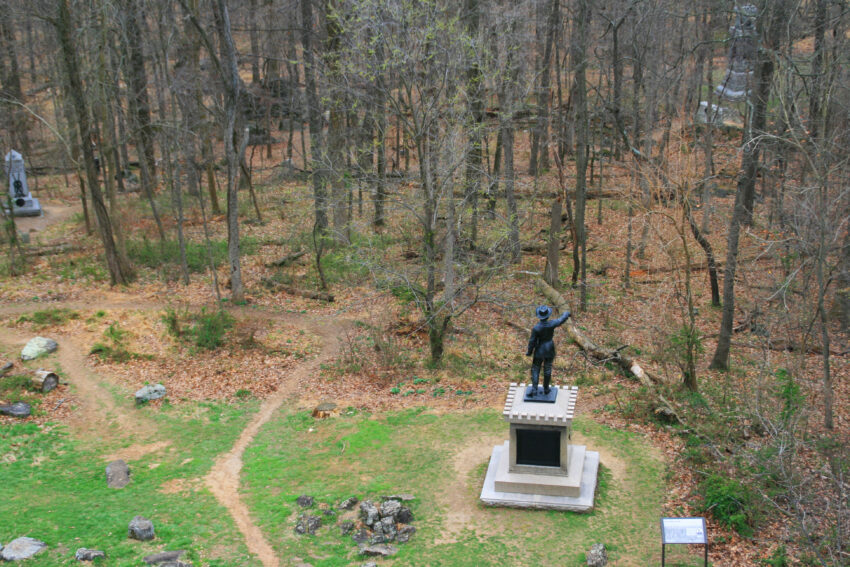
As much as I wanted to explore the rugged, rock-laden Big and Little Round Tops, the focal point of the second day’s conflicts, both were unavailable during our visit due to road repairs. However, I stood near the large, strewn boulders of The Devil’s Den, walked through the remnants of the Peach Orchard and stood upon the Wheat Field before arriving at Cemetery Ridge.
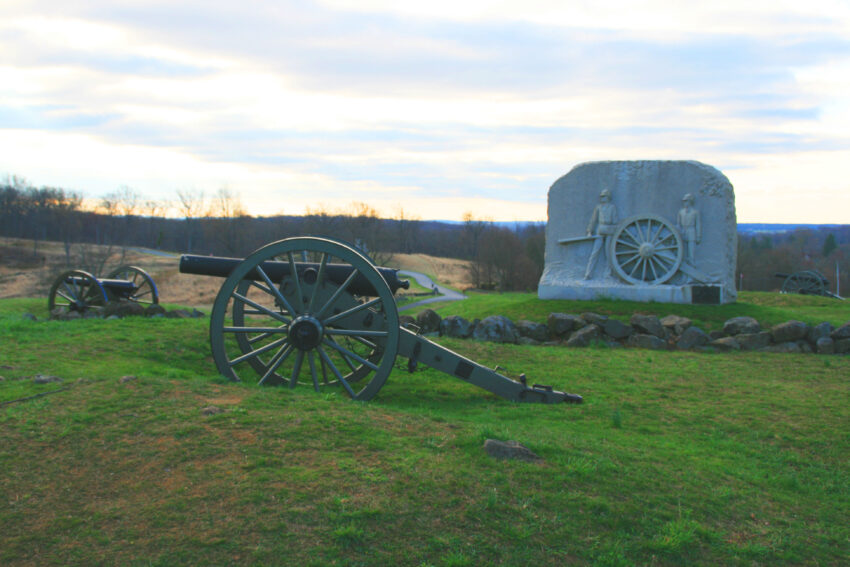
Cemetery Ridge is barely 40 feet high. It is here that you find the Angle’s stone wall and the copse of trees whose presence provided a landmark to guide the attacking Confederates. It is where the Union, in desperate hand-to-hand fighting, turned away the final impetus of the rebel onslaught.
We had to stop at the State of Pennsylvania Monument which is the largest monument on the Gettysburg battlefield. The tip of the sword of the statue of Winged Victory is 110 feet high. A spiral staircase took us to the roof of the monument with its panoramic views of the battlefield.
Our final stop was Seminary Ridge located west of town

Standing on Seminary Ridge beneath the towering, 41 feet high Virginian monument topped with the statue of General Lee and his horse, Traveler, I gazed incredulously across the fields towards Cemetery Ridge and the Union lines.
Final Attack of the Day
From here, the final day’s massive attack, known to history as Pickett’s charge, against the Union’s center, commenced.
Approximately 12,500 men advanced across open fields for nearly a mile under heavy Union artillery and rifle fire.
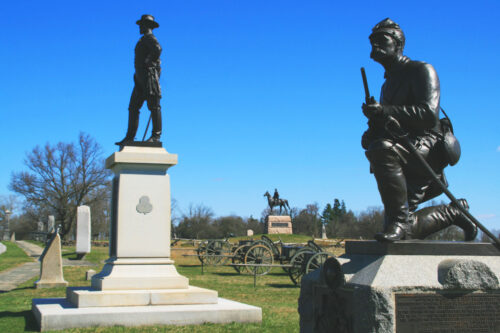
In what is euphemistically referred to as the “high-water mark of the Confederacy” they crashed themselves against the center of the Union lines at the place called the Angle near that group of trees. The Union broke the attack and drove them back with horrific casualties.
I was reminded of the famed historian Shelby Foote’s thoughts on the attack:
If I had been in one of Pickett’s regiments and they had told me what we were going to do and I had had a look at that field and have seen that ridge nearly a mile across the way and all those guns and all those soldiers I would have said I don’t think we ought to do that general.And I might have had the nerve enough to say I ain’t gonna do it.Of course, I wouldn’t; nobody would have that much nerve.You couldn’t say, ‘Marse Robert, I ain’t going.’
Of course, they did go.
While I reflected on the enormity of events that had occurred on these quiet fields it, again, was my wife who startled me back to the present with a simple question as she pointed to General Lee, “Who is that?” When I told her, she responded, “Why is there a statue for him? Isn’t he the bad guy?”

It reminded me that I had spent the last 24 hours hiking across the revered fields, recreating in my mind’s eye the events of over a century and a half ago. I had dwelt on the unimaginable struggles of the tens of tens of thousands of stout young men who fought here. Their valor. Their glories. Their defeats. The tragic carnage that gripped both armies.
What I cannot, should not forget is that the battle was fought for and against an ideology whose very concept is appalling. One army fought to maintain the very fabric of a nation that had recently reinvested in the idea that all men are created equal. The other army fought to tear that very fabric asunder in order to preserve a system that enslaved an entire race of people.
Her question was a simple one. I don’t have a simple answer.
As we drove out of town, past the Visitor’s center and its seated bronze of President Lincoln, his 2 nd inaugural address came to mind which may form the beginnings of an answer,
“With malice toward none, with charity for all, with firmness in the right as God gives us to see the right, let us strive on to finish the work we are in, to bind up the nation’s wounds”
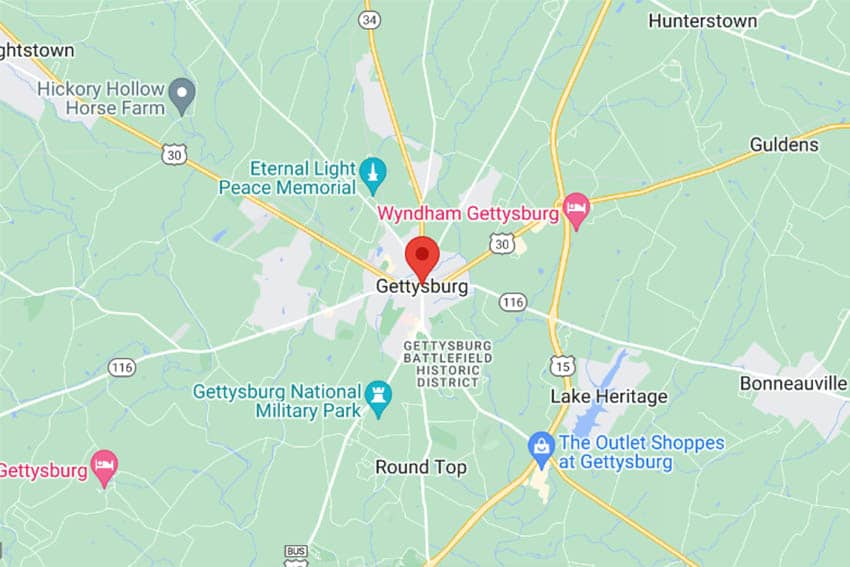
Going to Gettysburg
Gettysburg National Military Park is located in Adams County, Pennsylvania.
1195 Baltimore Pike
Gettysburg, PA 17325
Gettysburg National Military Park Pennsylvania
Gettysburg Museum & Visitor Center
A Park Map and Guide is available at the information desk of the Visitor’s Center. This brochure offers suggestions for seeing the battlefield including the self-guided auto tour, driving tips, walking trails, and a brief overview of the battle, the Gettysburg National Cemetery, and Lincoln’s Gettysburg Address.

Frank Hosek is an Illinois-based Director of Human Resources who revels in traveling with his wife, Kathy.He enjoys discovering new experiences, meeting the people that make those experiences enjoyable, and sharing their adventures. He is a freelance writer for newspapers, magazines, and travel websites
- These 9 U.S. National Parks Require Reservations in 2024 - April 17, 2024
- Take a Hike in Olympic National Park - April 17, 2024
- The Wild Mississippi: 2340 Miles Across Ten States - April 8, 2024



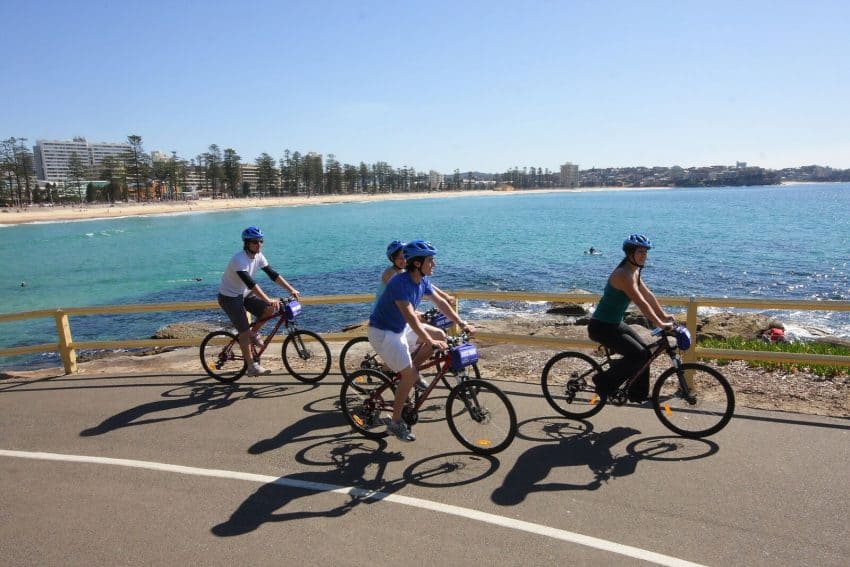

Interesting article! I particularly appreciated your personal reflections!